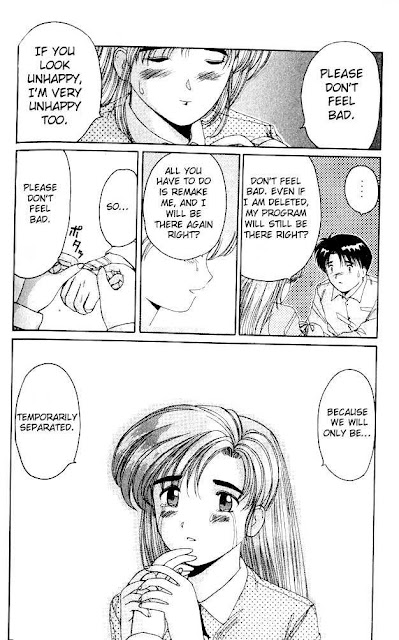A.I. LOVE YOU was the breakthrough manga for mangaka Ken Akamatu, later known for such popular works as LOVE HINA and NEGIMA. A.I.'s premise was that Hitoshi, a high schooler with zero social skills, used his computer skills to design a program to allay his loneliness. He's able to interact with "Program 30," who has the image of a cute girl, the better to fantasize about having a real girlfriend. A freak accident brings the program to life, so that Hitoshi now gets to live with a pretty girl, though being a living computer program, she doesn't understand sex. So A.I. falls into the category of many similar comedies-- from I DREAM OF JEANNIE to URUSEI YATSURA-- in which an ordinary guy maintains a more or less monastic existence with a hot babe, getting the experience of emotional bonding but without sex. As a compensating perk, though, "Saati Namba"-- the rendering of "Number Thirty" into a combination of Japanese and English-derived slang-- can manifest all sorts of cyber-magic, like illicitly increasing Hitoshi's bank account by "talking" to the bank's computers.
As is often the case with romances involving artificial beings, it's almost inevitable that the A.I. character will take on increasing humanity. "The Smiling Invader" is interesting in that the human Hitoshi is the one who must learn more about the ways of A.I., as they are affected by the evolving technology of the Internet-- specifically, the way in which programs can be infected by viruses.
The story starts off with Hitoshi catching the flu, while Saati chastely tends him. Not knowing much about human diseases, she attempts to research the subject online. But because she's literally interacting with the computer, she catches a computer virus.
After a number of incidents in which Saati either malfunctions or collapses outright, Hitoshi realizes that she's been infected, but since he's keeping her existence a secret, he alone can cure her malady.
Reading this 1990s story today entails something of a flashback experience, as one of the main tools Hitoshi is the now extinct tech of "floppy discs." To build suspense, Akamatsu has Hitoshi go down a false trail, one that only appears to cure Saati, before her illness undergoes a resurgence.
In trying to see what happened, Hitoshi is hailed by an automatic program, "Peter 4," constructed by the unknown virus-designer. Peter 4 takes the form of a clown, implicitly to mock the futile efforts of the "computer geek" seeking to reverse the infection.
Saati tries to soothe her creator's worries by remining him that even if she is erased, he can still recreate her with the original program. But in classic romance-story tradition, Hitoshi only wants the original Saati, no imitations need apply. In later stories, which I have not re-examined, Hitoshi and Saati encounter the malicious designer of Peter 4, whom Akamatsu named "Billy G" as part of some arcane reference to Bill Gates.
Since it's a serial romance, of course Hitoshi saves her with his tech-insight, albeit with only minutes to spare. But the core myth of the story is that if an A.I. intelligence comes to life, then it will be just as individual, and hence irreplaceable, as any organic creature.









No comments:
Post a Comment